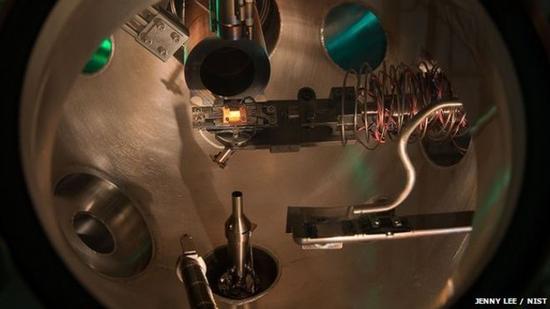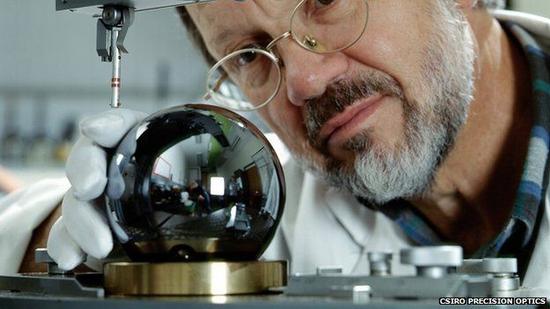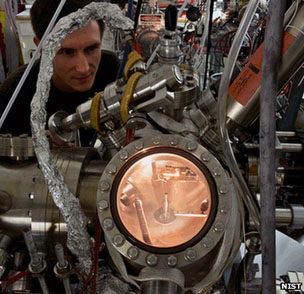Beijing time on June 12 news, according to the British Broadcasting Corporation (BBC) website reports, in order to manufacture quantum computers, the general sense of pure silicon material is not enough to solve the problem, people need a specific type of silicon atoms. The ideal material is silicon-28, and recently physicists in the United States have designed a method that can produce silicon-28 materials that are 40 times more pure than traditional methods. Even more exciting is that researchers now only need to complete the entire preparation process in their own laboratories, instead of having to rely on a specially modified giant plutonium reactor near St. Petersburg, Russia, as it did 10 years ago. in production.

When the silicon material is prepared in a vacuum chamber at a high temperature, it can be seen that the collected silicon material is emitting bright light.

The vast majority of the world's ultra-pure silicon-28 has been used to make 1 kilogram weight spheres as part of the Avogadro constant measurement project

The new method developed by American scientists to prepare ultrapure silicon-28 material mainly relies on the application of mass spectrometry. The original design of this device was to identify the composition of the material.
This is a significant technological advance that has made people take a big step towards solving the problem of insufficient supply of raw materials for quantum computers.
Manufacturing a quantum computer
Several designs for building quantum computers are based on silicon. One of the most widely-recognized solutions is to store qubits in the atoms of another element, such as phosphorus, and to embed them in a thin layer of ultrapure silicon-28. .
The so-called "qubit" is the quantum corresponding version of the "bits" in the traditional computer, which is similar to the way that traditional computers use 0 or 1 to store information. The reason why scientists believe that quantum computers will be able to start a new era of computing is because they can deal with 0 and 1 at the same time, so as to achieve an incredibly fast computing speed for conventional computers, or to perform incredibly complex calculations.
However, the biggest difficulty for this kind of silicon-based design is that there are many silicon atoms in the conventional silicon material that are not silicon-28. Almost 8% of the commercial silicon wafers on the market are made of other materials. Made of silicon isotope material, such as silicon-29, such materials can cause quantum chips to fail.
Dr. Joshua Pomeroy was a participant in this development work and was from the National Institute of Standards and Technology in Maryland, USA. He said: "This will lead to a decoherence effect, which is a bit like a computer suffering from Attention Deficit Disorder (ADD)." Researchers working in this field, such as Dr Joshua, have to rely on the enrichment produced by Russia. Silicon-28 remnants work.
A plutonium nuclear reactor in St. Petersburg, Russia, has been specially transformed into a refinery, which includes an industrial-grade gas centrifuge designed by German experts. It was installed and put into operation in 2004. This device can produce silicon-28 material with a purity of 99.99%.
The sample produced here was made into a material weighing 5 kilograms and cost about 1 million euros. The project is part of an international cooperation project aimed at accurately determining Avogadro's constant based on 1 kg of pure silica-28 spheres.
The use of the remaining remnants of the project is almost the only way to obtain this purity-grade silicon material in the world.
Dr. Pumiroy said that the quantum academic community cannot request the resource industry to produce this high-purity silicon material. He stated that the existence of the Avogadro project was entirely accidental. He said: "So we all had a nervous mood. When this project was finally completed, they no longer provided us with this high purity silicon material. What should we do then?"
However, Dr. Promy Roy and his colleagues have clearly given a basic answer. They recently exhibited a small amount of self-produced high-purity silicon-28, with a purity of 99.9998%. And these materials can be completed in just a few devices that are readily available in the lab.
Mass spectrometry separation technology
The most important equipment they rely on to complete this work is the mass spectrometer, a device that is commonly used to identify material constituents. The principle is to measure the mass of different atoms in a sample to distinguish different elemental constituents. By sending silicon ions into a large magnetic field, different silicon isotopes with different masses can be separated from each other because heavier silicon isotopes are deflected by the magnetic field at a smaller angle, and those with lighter masses Ions undergo greater deflection under the influence of a magnetic field.
Dr. Promy Roy said this is a simple and unexpected solution. He said: "We have encountered something that often happens in science. That is, we have a device and its function has reached its limit. But we suddenly have a new problem that needs to be solved. This device is just right for it. â€
The silicon-28 flakes produced by Dr. Piro's team using this technique are very pure, but they are also very small.
He said: "It would be much more difficult to use this technology to produce a larger number of samples, but because it is only for research, such a large number is not necessary in itself."
Although there are some controversial commercialization initiatives, the overall quantum computer still stays at the technological research stage. According to Dr. Pumiroy, the new silicon-28 purification technology developed by them at this time will help scientists in other laboratories to extract the ultra-pure silicon-28 materials needed for experiments and to experiment with various types of quantum computer design solutions. And verification. He said: "We realized that we didn't need to produce enough ultrapure silicon-28 material to make a full silicon wafer. All we needed was to isolate the computer from the other parts of the silicon wafer. "The relevant papers on this research have been published in the Journal of Physics D.
Indoor Rental LED Screen Display,Indoor Stage Rental LED Display
SHENZHEN YGHQ Optoelectronics Co.,ltd. , https://www.leds-smd.com